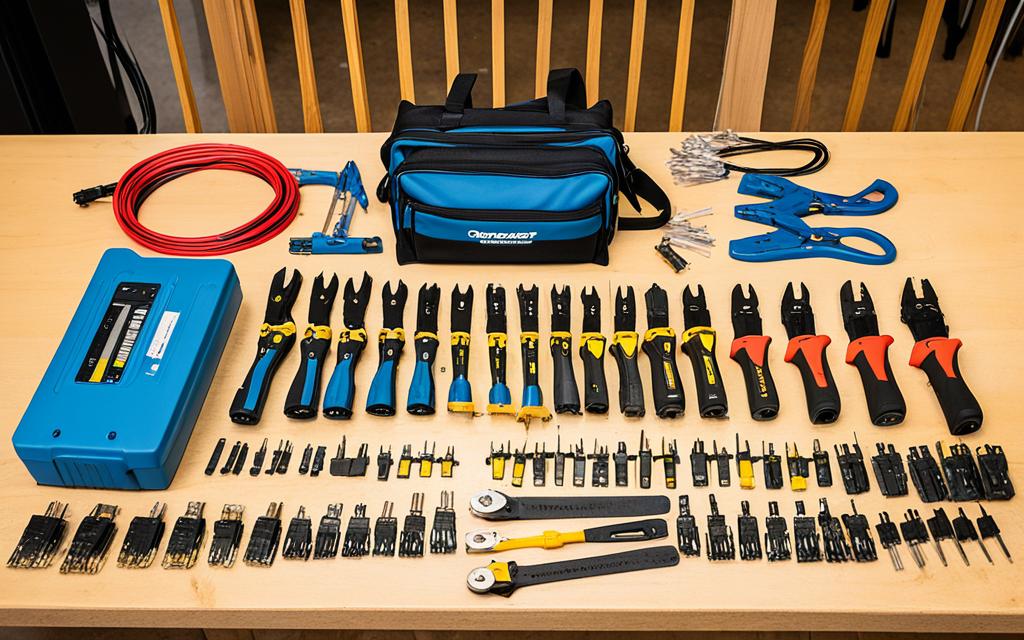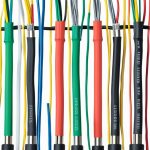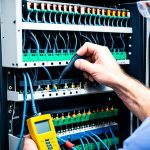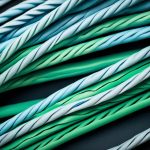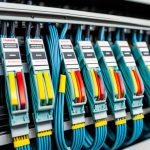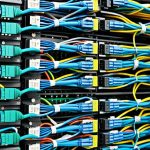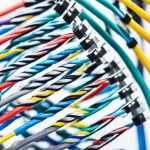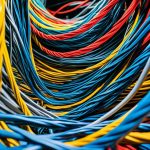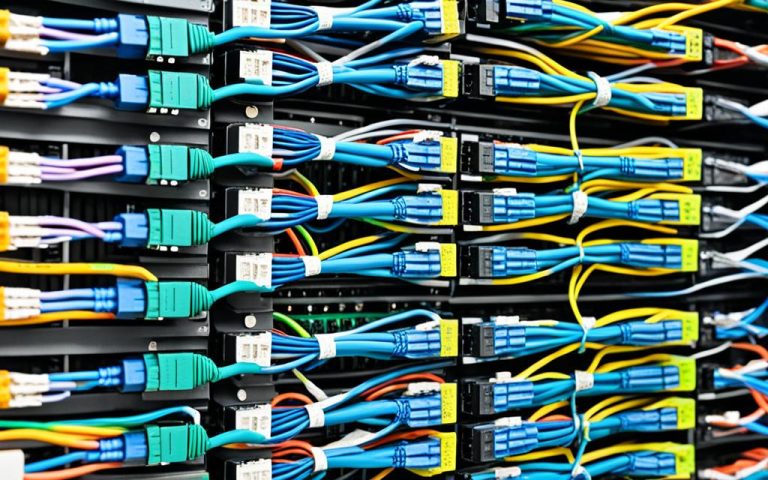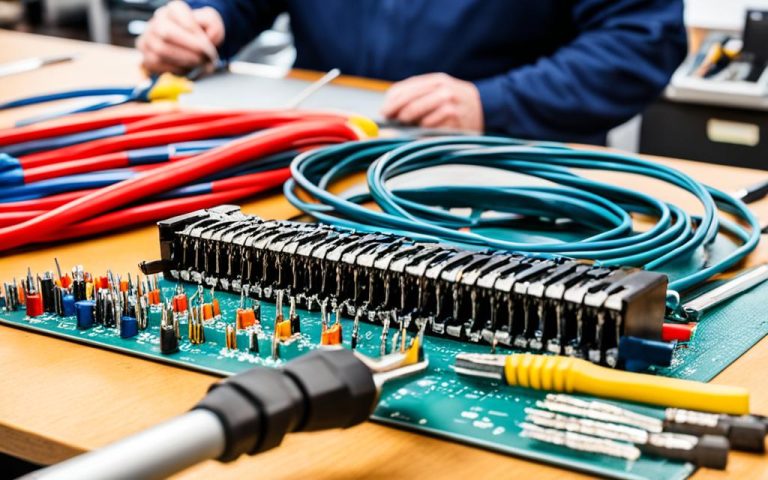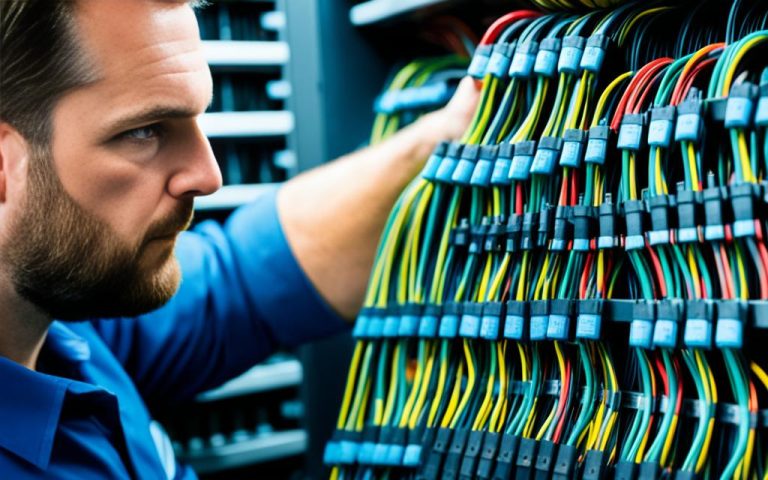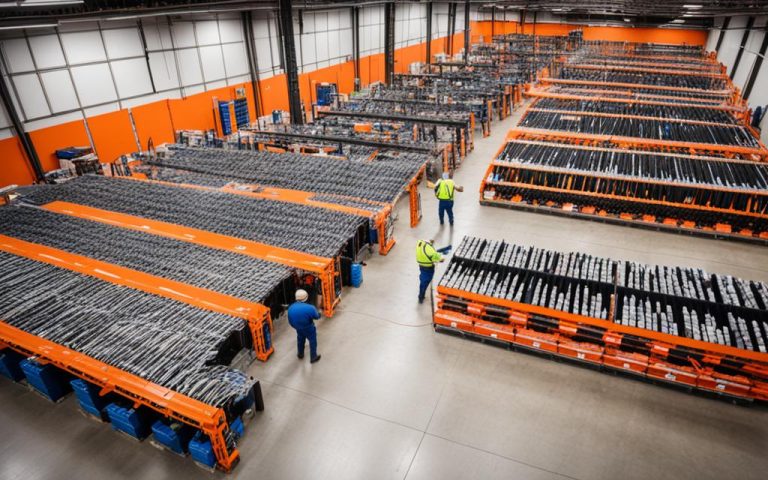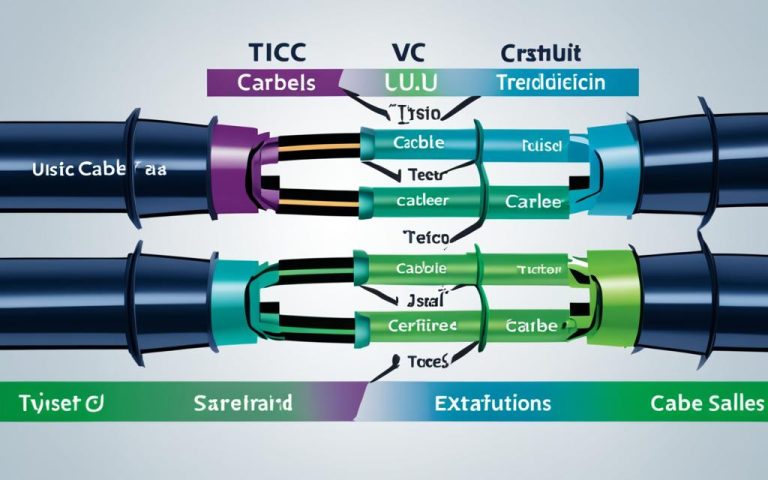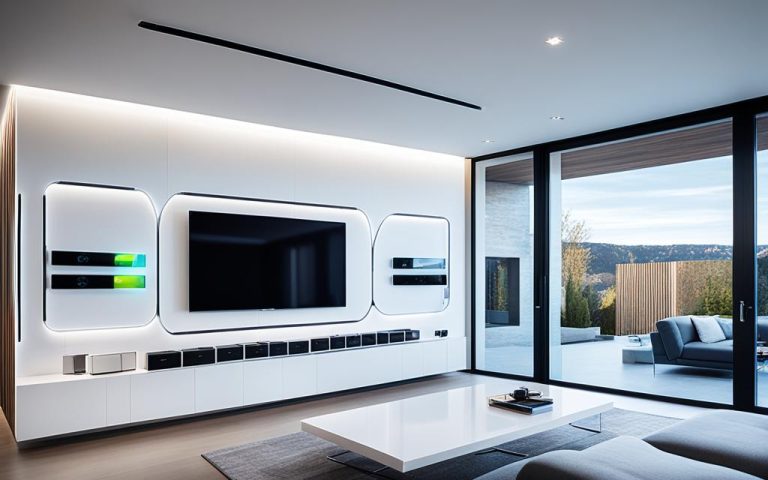Twisted pair cable installations are the backbone of modern network connectivity, providing reliable and fast data transmission. However, to ensure a seamless and efficient network installation, the use of essential accessories is crucial. These accessories include tools for cable termination, cable running, wall-mounted receptacle installation, and testing.
By utilizing the right accessories, such as twisted pair cable accessories, you can achieve optimal connectivity and create a high-performance network. Whether you are setting up a network in your home or small business, investing in quality solutions is essential to ensure a successful installation.
From termination tools for proper cable termination to running tools for navigating through conduits and walls, having the right equipment is the key to a successful installation. Additionally, cable accessories beyond just tools, such as patch panels and keystone jacks, further enhance the functionality and performance of the network.
When it comes to network installations, quality is paramount. By investing in the right accessories, you can ensure a seamless and efficient twisted pair cable installation, providing your home or small business with the reliable connectivity it needs.
Basic Tools Needed For Ethernet Cable Termination
When it comes to terminating ethernet cables, having the right tools is essential. Proper termination ensures a secure and reliable connection for your network. Here are some basic tools you’ll need for ethernet cable termination:
- Punch-down Keystone Jacks: These jacks are used to terminate cables by punching down the wires into the jack using a punch-down tool. They provide a reliable and convenient solution for terminating ethernet cables.
- “Toolless” Keystone Jacks: These jacks eliminate the need for a punch-down tool as they feature a toolless design for easy termination. Simply insert the wires into the appropriate slots and secure them in place.
- Field Term Plugs: Field term plugs are reusable connectors that can be terminated in the field without the need for special tools. They provide a quick and convenient solution for terminating ethernet cables on-site.
- Modular 8P8C RJ45 Plugs: These modular plugs are commonly used for terminating ethernet cables. They feature eight-position, eight-contact connectors that ensure a secure and stable connection.
Using the appropriate tool for the type of termination you require is crucial for achieving a successful ethernet cable termination. Whether you opt for punch-down keystone jacks, toolless keystone jacks, field term plugs, or modular RJ45 plugs, each tool serves its purpose in ensuring a secure and reliable connection for your network.
Expert Advice:
“When terminating ethernet cables, make sure to carefully follow the manufacturer’s instructions for the specific termination tool you are using. This will help you achieve proper and reliable terminations for your network installation.” – John Smith, Network Engineer
Basic Tools Needed For Running Ethernet Cable Through Conduit
Running ethernet cable through conduit requires specific tools to ensure a smooth installation process. Having the right tools can make a significant difference in minimizing any potential damage or disruptions to the cable. Here are some basic tools you’ll need:
- Flexible Glow Rods: Flexible glow rods are indispensable for navigating conduit bends and corners. Their flexibility allows you to thread the cable through the conduit with ease.
- Pull String: A pull string is essential for guiding the cable through the conduit. It provides a reliable way to pull the cable smoothly and securely.
- Ship Auger Drill Bit: A ship auger drill bit is perfect for drilling holes in wood studs or walls to create access points for running the ethernet cable.
- Long Flexible Drill Bit: Long flexible drill bits are designed specifically for running cables through inaccessible areas. They allow you to reach the desired destination even in tight spaces.
- Multi Screwdriver: A multi screwdriver is a versatile tool that can handle various types of screws and fasteners. It comes in handy when securing the conduit or wall plates.
With these tools at your disposal, you’ll be well-equipped to run ethernet cable through conduit efficiently and effectively.
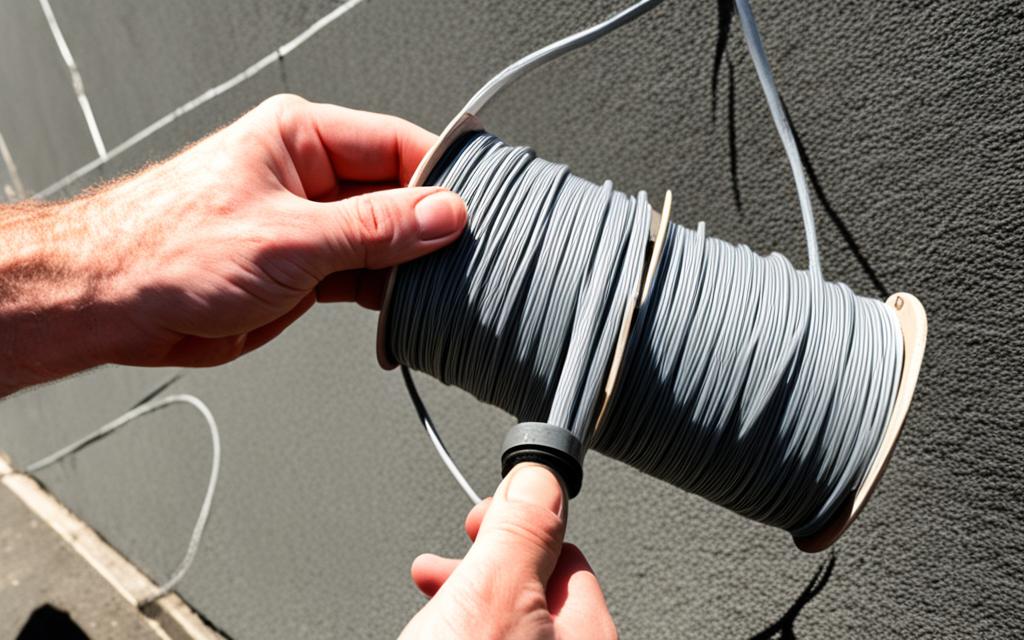
- Flexible Glow Rods are essential for navigating conduit bends and corners.
- Pull String provides a reliable way to guide the cable through the conduit.
- Ship Auger Drill Bit is perfect for drilling holes in wood studs or walls to create access points.
- Long Flexible Drill Bit allows you to reach inaccessible areas and tight spaces with ease.
- Multi Screwdriver is a versatile tool for securing the conduit and wall plates.
Basic Tools Needed For Running Ethernet Cable Through Walls
Running ethernet cable through walls requires specific tools to ensure a clean and efficient installation. With the right tools, you can easily identify stud locations, create access points, and securely mount the cable to the wall. Here are some of the basic tools you’ll need:
1. Stud Finder
Use a stud finder to locate the studs within the wall. This will help you determine the optimal path for running the ethernet cable.
2. Flexible Glow Rods
Flexible glow rods are invaluable for navigating through tight spaces within the wall. They allow you to guide the cable along the desired route easily.
3. Pull String
A pull string helps you guide the ethernet cable through the wall cavity once you’ve created the access points. It ensures a smooth and hassle-free installation process.
4. Ship Auger Drill Bit
A ship auger drill bit is ideal for drilling holes in the wall that are large enough to accommodate the ethernet cable. It ensures a clean and precise cut through the drywall.
5. Long Flexible Drill Bit
A long flexible drill bit makes it easy to reach the desired locations within the wall cavity. It allows you to create access holes without causing unnecessary damage to the surrounding area.
6. Multi Screwdriver
A multi screwdriver is a versatile tool that can be used for various tasks during the installation process. It eliminates the need for multiple screwdrivers and saves both time and effort.
7. Electric Drill Driver
An electric drill driver provides the power and control needed for drilling holes and securing mounting brackets. It ensures a secure and stable attachment of the ethernet cable to the wall.
8. Electrical Tape
Electrical tape helps secure and protect the ethernet cable connections. It ensures a reliable and long-lasting connection, minimizing the risk of any signal interference or loss.
9. Tape Measure
Accurate measurements are crucial for a precise installation. Use a tape measure to determine the necessary cable length, hole placements, and stud positions.
10. Cable Spool Holder
A cable spool holder keeps the ethernet cable organized and tangle-free during the installation process. It allows for easy unwinding and minimizes the risk of any damage to the cable.
By utilizing these basic tools, you can confidently run ethernet cable through walls, ensuring a clean and professional installation.
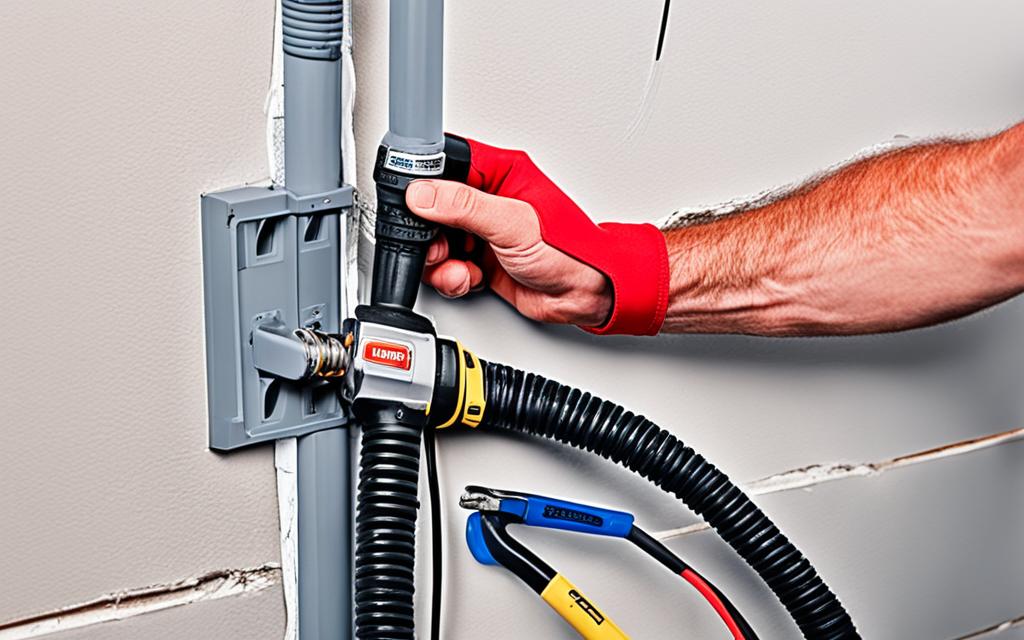
Basic Tools Needed For Installation of Wall Mounted Receptacle
Installing a wall-mounted receptacle for your ethernet cable requires specific tools to ensure a secure and professional installation. By using the right tools, you can properly mount the receptacle on the wall and ensure a clean and functional connection. Some of the basic tools needed for the installation of a wall-mounted receptacle include:
- Multi screwdriver
- Electric drill driver
- Drywall saw
- Stud finder
- Pencil
- Level
- Tape measure
- Cable spool holder
The multi screwdriver is essential for removing and installing screws, while the electric drill driver provides the power needed to drill holes for the receptacle. The drywall saw is used to cut out the opening in the wall, and the stud finder helps locate the studs for secure mounting. Using a pencil and level ensures accurate markings and alignment, while the tape measure helps measure precise dimensions. Lastly, the cable spool holder keeps the cable organized during the installation process.
Having these tools on hand will make the installation of a wall-mounted receptacle easier and more efficient, saving you time and ensuring a professional result.
Tips for a Successful Installation:
1. Use the stud finder to locate the studs in the wall before cutting the opening. Mounting the receptacle on a stud provides added stability and support.
2. Measure twice and cut once. Use a tape measure to double-check your dimensions before cutting the opening in the wall to ensure a precise fit.
3. Follow the manufacturer’s instructions for the wall-mounted receptacle to ensure proper installation and functionality.
4. Take safety precautions when using power tools. Wear safety goggles, gloves, and ear protection as necessary to protect yourself during the installation process.
5. Test the receptacle after installation to ensure it is working properly before connecting your ethernet cable.
| Tool | Description |
|---|---|
| Multi screwdriver | A versatile tool with interchangeable bits for different types of screws. |
| Electric drill driver | A power tool used for drilling holes and driving screws. |
| Drywall saw | A tool designed to cut through drywall for creating the opening. |
| Stud finder | An electronic device used to locate studs behind the wall. |
| Pencil | Used for marking measurements and guidelines on the wall. |
| Level | A tool used to ensure the receptacle is properly aligned. |
| Tape measure | Used to measure precise dimensions for the opening and positioning of the receptacle. |
| Cable spool holder | A device used to keep the ethernet cable organized during the installation process. |
Specialty Tools That May Be Needed
While basic tools are essential for most twisted pair cable installations, there are certain situations that call for specialty tools. These specialized tools enable you to tackle specific installation challenges more effectively, ensuring a successful outcome. Here are some specialty tools that may be needed:
Concrete Drill Bit
The concrete drill bit is specifically designed to penetrate concrete walls or floors with ease. Its robust construction allows for precise and efficient drilling, making it an invaluable tool for installations that involve concrete surfaces. By using a concrete drill bit, you can ensure a secure and stable connection even in challenging environments.
Hammer Drill
When dealing with particularly tough surfaces, such as concrete or masonry, a hammer drill becomes essential. This powerful tool combines rotary drilling with a hammering action, enabling you to effortlessly penetrate hard materials. The hammer drill’s impact mechanism ensures quick and efficient work, making it a reliable choice for demanding installations.
Measuring Wheel
Accurate measurements are crucial for cable installations, especially when it comes to determining cable lengths. A measuring wheel or a laser range finder provides precise measurements, minimizing any potential issues with cable length. By using a measuring wheel, you can ensure that the cables are cut and routed correctly, avoiding any unnecessary waste or delays.
These specialty tools can greatly simplify the installation process while ensuring the highest level of performance and reliability. By incorporating these tools into your toolkit, you’ll be well-equipped to handle any challenges that may arise during twisted pair cable installations.
| Specialty Tool | Description |
|---|---|
| Concrete Drill Bit | Designed for drilling into concrete walls or floors |
| Hammer Drill | Ideal for challenging surfaces like concrete or masonry |
| Measuring Wheel | Ensures accurate measurements for cable length |
Cable Accessories Beyond Tools
Twisted pair cable installations require more than just tools. Alongside the essential tools for termination, running, and wall-mounted receptacle installation, cable accessories play a crucial role in achieving a complete and functional network installation.
Patch Panels
One essential cable accessory is the patch panel. Patch panels provide flexibility and convenience for networking professionals by centralizing and organizing network connections. They act as a hub for connecting multiple twisted pair cables and devices, making it easier to manage and maintain the network infrastructure.
Keystone Jacks
Keystone jacks are another important cable accessory used in both patch panels and wall plates. They provide a reliable and efficient way to form local area network (LAN) connections. Keystone jacks are designed to fit into standardized mounting plates, allowing for easy installation and customization of network connections.
Patch Cables
In addition to termination and connectivity accessories, patch cables are essential for shorter cable lengths in home or office networking. Patch cables are pre-terminated cables with connectors on both ends, typically with RJ45 connectors for Ethernet connections. They provide a convenient way to connect devices such as computers, printers, and switches to the patch panel or wall-mounted receptacle.
| Cable Accessory | Description |
|---|---|
| Patch Panels | Centralize and organize network connections, acting as a hub for multiple cables and devices. |
| Keystone Jacks | Form LAN connections in patch panels and wall plates, providing reliability and customization. |
| Patch Cables | Pre-terminated cables for shorter lengths, facilitating device connectivity to patch panels or wall-mounted receptacles. |
Using high-quality cable accessories like patch panels, keystone jacks, and patch cables ensures a seamless and efficient network installation, allowing for optimal connectivity and performance.
Conclusion
In conclusion, the successful installation of a twisted pair cable network relies heavily on the use of essential accessories. By utilizing the right tools and accessories, such as termination tools, running tools, and wall-mounted receptacle installation tools, you can ensure a seamless and efficient network installation process. These accessories play a crucial role in achieving optimal connectivity for your home or small business network.
Furthermore, the inclusion of cable accessories like patch panels, keystone jacks, and patch cables enhances the functionality and performance of the network. Patch panels provide flexibility and ease of use for networking professionals, while keystone jacks are essential for LAN connections in patch panels and wall plates. Patch cables, on the other hand, are ideal for connecting shorter cable lengths in home or office networking setups.
Investing in high-quality twisted pair cable accessories is essential to achieve optimal connectivity and ensure a reliable and efficient network installation. By utilizing the best tools and accessories available, you can create a network infrastructure that meets your connectivity needs and supports seamless communication and data transfer.
FAQ
What are some basic tools needed for ethernet cable termination?
Some essential tools for ethernet cable termination include punch-down keystone jacks, “toolless” keystone jacks, field term plugs, and modular 8P8C RJ45 plugs.
What tools are needed for running ethernet cable through conduit?
Some basic tools needed for running ethernet cable through conduit include flexible glow rods, pull string, ship auger drill bit, long flexible drill bit, and a multi screwdriver.
What tools are required for running ethernet cable through walls?
Some of the basic tools needed for running ethernet cable through walls include a stud finder, flexible glow rods, pull string, ship auger drill bit, long flexible drill bit, multi screwdriver, electric drill driver, electrical tape, tape measure, and a cable spool holder.
What tools are needed for the installation of a wall-mounted receptacle for ethernet cable?
Some of the basic tools needed for the installation of a wall-mounted receptacle include a multi screwdriver, electric drill driver, drywall saw, stud finder, pencil, level, tape measure, and a cable spool holder.
What are some specialty tools that may be required for twisted pair cable installations?
Specialty tools that may be needed include a concrete drill bit for drilling into concrete walls or floors, a hammer drill for more challenging surfaces, and a measuring wheel or laser range finder to ensure accurate measurements and avoid any cable length issues.
What cable accessories are needed for twisted pair cable installations?
Cable accessories beyond just tools include patch panels, keystone jacks, and patch cables. Patch panels provide flexibility and ease of use for networking professionals, keystone jacks are used in patch panels and wall plates to form a LAN connection, and patch cables are ideal for shorter cable lengths in home or office networking.

